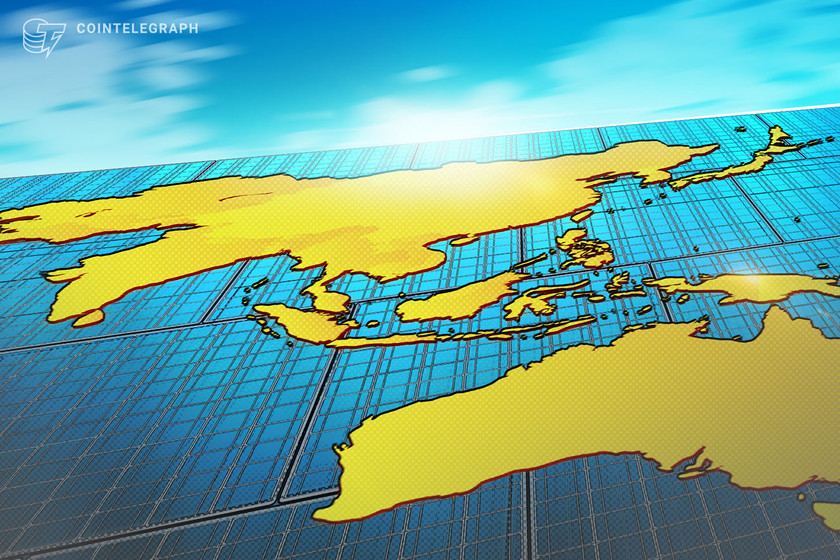Asia-Pacific’s solarized digitalization agenda in pandemic times

Amid the COVID-19 pandemic, the role of digitalization has become central to achieving sustainability and lessening climate change.
The virtual 7th Asia-Pacific Climate Change Adaptation Forum was jointly hosted by the Ministry of the Environment of Japan and the Asia Pacific Adaptation Network with the theme “Enabling Resilience for All: The Critical Decade to Scale-up Action.” The forum took place in March and was held to formulate national adaptation planning for science and technology, and energy and fiscal policies that consider the interlinkages between climate change, health and biodiversity.
These nature- and ecosystem-based policies will serve as the basis for the Asia-Pacific region’s contributions to the Leaders Summit on Climate in the United States; the United Nations Biodiversity Conference (COP 15) in Kunming, China; and the United Nations Climate Change Conference (COP 26) in Glasgow, Scotland.
The Asia-Pacific region accounts for 60% of the global population (around 4.3 billion people). It has the world’s fastest-rising economies, which are supported by innovations in technology and cryptocurrency that are energy-intensive. This results in the highest growth in electricity generation, fueled predominantly (85%) by fossil fuels.

Three out of the six largest carbon dioxide-emitting countries in the world — China, India and Japan — are in the Asia-Pacific region, an area that produces about half of the world’s carbon dioxide emissions. As a result, the region is also increasingly impacted by extreme weather events.

With 2020 witnessing the COVID-19 pandemic and being the warmest year on record, there is an urgent need to decouple economic growth from greenhouse gas emissions in order to transition the Asia-Pacific region toward carbon neutrality. A few countries in the Asia-Pacific region — including Japan, South Korea, Bhutan, Fiji, the Maldives, the Marshall Islands and Nepal — have declared their aim to be carbon neutral by 2050; and China has set its target as 2060. These commitments are incorporated in their nationally determined contributions.
Related: The pandemic year ends with a tokenized carbon cap-and-trade solution
A newly released International Monetary Fund departmental paper makes fiscal policy recommendations for the region focused in three areas:
- Increase in the use of carbon taxes
- Increase in the ability to adapt to climate change;
- Increase pandemic spending for greener activities.
These recommendations are aimed at addressing climate change in the Asia-Pacific region.
Turning digital technology innovation into climate action in the Asia-Pacific region
With the COVID-19 pandemic, industrial digitalization has entered a new phase of explosive development.
Houlin Zhao, secretary-general of the International Telecommunication Union — which organizes events and publishes reports to raise awareness around the role of frontier technologies with regard to the environment, climate change and the circular economy — explained:
“Today, we are faced with not one but two deep transformations. The first one, driven by emerging technologies such as artificial intelligence, blockchain, the Internet of Things, 5G and many others, is changing how governments, businesses and individuals will act in this new century. As for the second transformation, climate change, it disrupts ecosystems, jeopardizing biodiversity, food and water security and the future of life on our planet. The question for us is whether humanity can turn this digital revolution into climate action and, most importantly, whether we can do it before it is too late.”
As Zhao continues: “With more and more people coming online, more data being generated and more devices connecting to the network, the digital ecosystem’s carbon footprint is growing.”
The Asia-Pacific region boasts tremendous potential, owing to the growing prominence of mobile payments and the development of central bank digital currencies, or CBDCs, in countries such as Australia, China, India, Japan, Singapore, South Korea and others. China’s Blockchain-based Service Network is developing a global network that will support future CBDCs from multiple countries.
Related: How the digital yuan stablecoin impacts crypto in China: Experts answer
The adoption of 5G technology is a catalyst for the implementation of blockchain to improve scalability and interoperability. And China’s Huawei and ZTE; South Korea’s Samsung and LG Electronics; and Japan’s Sony and NEC are leading the way in 5G technology.
Huawei was the world’s first company to offer 5G technology and ranks number one as a global telecommunications equipment maker. However, the United States is restricting the company’s access to American technology that is key to producing modern 5G handsets and new 5G-capable mobile telecommunications infrastructure. As a result, the company has seen its market share decline outside China.
This has also had a spillover effect on blockchain technology adoption, which enables telecommunications infrastructure to meet unprecedented service-level requirements by bolstering operations, data sharing and customer identity verification, and detecting telecom fraud. According to Denian Shi, deputy chief engineer of the China Academy of Information and Communications Technology, the development of the global blockchain industry saw reduced investment/financing and cooled down during 2019 and 2020.
The role of digitalization has become central to continued economic and societal activity and to lessening the pandemic’s impact. According to recent reports, the Asia-Pacific region is expected to contribute about 19.3% of the overall global spending on blockchain technology, fueled by increased investments by the fintech sector. Integration of biometrics in smartphones amid the COVID-19 pandemic is expected to grow blockchain-based digital identity solutions by 21% annually.
The ever-increasing demand for connectivity and bandwidth by billions of devices in the region has made it important for wireless networks, blockchain platforms and computing devices to limit the total communications energy consumption and associated carbon footprint. With 5G being commercially deployed worldwide, LG Electronics and Huawei have already begun working toward launching 6G networks, which will be “50 times faster than 5G” in spectrum efficiency, positioning capabilities and mobility. Studies show that 6G could provide energy self-sustainability to the massive so-called “Internet of Everything,” with blockchain technology central to addressing significant challenges.
The world’s top solar energy adoption is in the Asia-Pacific region
The energy sector is the world’s number-one pollutant, accounting for 72% of global greenhouse gas emissions, according to the Center for Climate and Energy Solutions. With energy demands continuously increasing — pushing CO2 emissions to their highest levels in history — methods of generating large quantities of clean energy have become a survival concern for the Asia-Pacific region. As a result, the region has shifted its focus to the decarbonization of the grid and the production of electricity from renewable energy. During March alone, 65 new renewable power plant contracts were announced in the region, and nearly 80% of these plants are solar.
China leads the world as the top producer of solar energy, seeking to transform its industrial structure, economy and society with disruptive innovation in the next-generation photovoltaic module for earth and space applications. India ranks second, Japan third and Vietnam fourth in the region. Three out of these four countries are also conducting research on space-based solar power and power beaming as a solution for the region’s transition toward carbon neutrality, with Japan and China emerging as international leaders in this area.
Recently, the U.S. Naval Research Laboratory conducted its Photovoltaic Radiofrequency Antenna Module Flight Experiment, or PRAM-FX, to transform solar power into radio frequency microwave energy aboard the U.S. Space Force’s X-37B robotic space plane. According to Paul Jaffe, innovation power beaming and space solar portfolio lead at NRL, PRAM-FX is a 12-inch (30.5 centimeters) square tile that collects solar energy and converts it to microwave power, but does not beam it anywhere. Instead, the experiment gauges the performance of sunlight-to-microwave conversion.
The views, thoughts and opinions expressed here are the author’s alone and do not necessarily reflect or represent the views and opinions of Cointelegraph.



